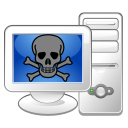 Image via Wikipedia
Image via WikipediaWhen you follow these 10 tips on the Internet and online security, you will discover were your computer system weaknesses are.
1. It is a fact that 75% of PC users do not use an updated antivirus program is a program that scans your PC looking for all malware, when discovered, they can either quarantine or delete them. Some AV programs even scan sites you visit and detect phishing sites.
2. phishing sites “are sites that have been created to look like a bank or payment processor like PayPal. We’ve all received emails from our bank stating our account is empty and immediately connect the hyperlink in the email you click on the real side, but the site he made for fraudulent, they are stealing money! Always make sure your banks website has a picture of a padlock on the toolbar, which shows that it is a safe place to log in. If you have any questions contact your bank immediately.
3. We all need a firewall to hide. This is a piece of software that prevents any intrusion into our computers, at home or at work. Once the software is installed is running in the background. Basically, it blocks the ports on our computers that hackers use to access the back door. Like the VA, there are many free firewall.
4. Your operating system upgrade? When is it updated? Most people will respond, ever. Major software companies like Microsoft, because the updates, is to connect all security vulnerabilities in software, so when I do an update, its wise to update your system.
5. Review all consumer equipment that uses, as there are products on the market called keyloggers, this is an electronic device that records all keystrokes and can be downloaded. So if you use the library of your online bank, eBay, make sure the keyboard cable is connected directly to your computer when connected to a piece of cable, could be a keylogger. The person who put there just download the information and have all your contact information and access to your money! Always disconnect and not save passwords on public computers – ever!
6. Check public WiFi connections are public! Make sure it is not just another computer that serves as a gateway, if you pass your details to them, a credit card and address, then you get Internet access. If you send emails, they are using your credit card to buy products online!
7. Do not share games, because that’s how some viruses were transferred from one computer to another. Run anti-virus scanner for the first disk.
8. Do not let anyone use a flash drive into your computer as soon as someone plugs a flash drive into a computer from a virus could be transferred to your computer, which may or may not be done on purpose, but problem is still there take the information from your computer and can even send email from your computer at a later date!
9. Physical protection at home and at work, which is essential to maintain the equipment and data stored on it falling into the wrong hands. The PC is a special steel box, which was designed to protect computers, so heating and security issues has been addresses, these units are fully welded and normally bolted to the walls (which is how banks protect their computers.)
10. The movement of physical protection is essential for laptops, so Kingston security offers the best option is a cable high-grade steel that locks into the laptop and links around a table leg, which prevent your personal information is stolen with the laptop in an accident and theft of support.
Follow these simple steps and offline and online security is safe.
so be secure and save data





